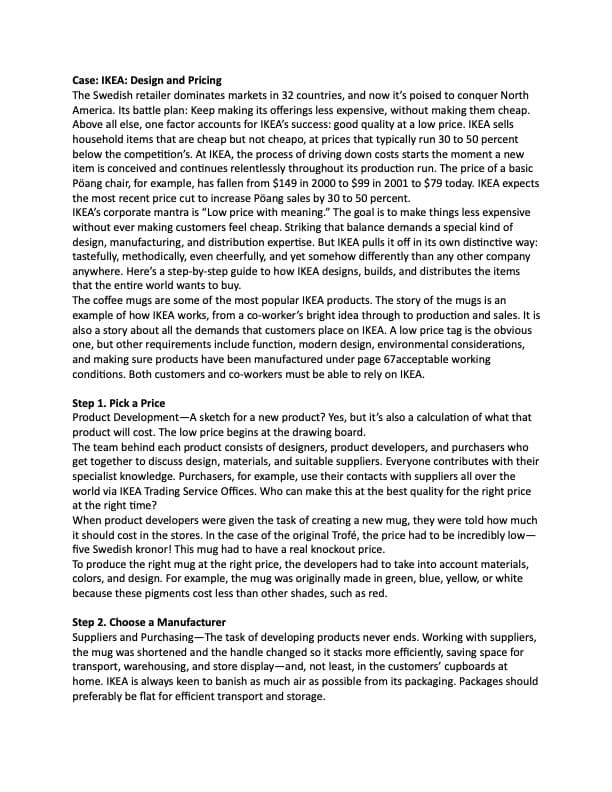Case: IKEA: Design and Pricing Please see the attached document to help with the questions Questions 1. What are IKEA’s competitive priorities? 2. Describe IKEA’s process for developing a new product. 3. What are additional features of the IKEA concept (beyond its design process) that contribute to creating exceptional value for the customer? 4. What would be important criteria for selecting a site for an IKEA store?
Case: IKEA: Design and Pricing Please see the attached document to help with the questions Questions 1. What are IKEA’s competitive priorities? 2. Describe IKEA’s process for developing a new product. 3. What are additional features of the IKEA concept (beyond its design process) that contribute to creating exceptional value for the customer? 4. What would be important criteria for selecting a site for an IKEA store?
Chapter1: Taking Risks And Making Profits Within The Dynamic Business Environment
Section: Chapter Questions
Problem 1CE
Related questions
Question
100%
Case: IKEA: Design and Pricing
Please see the attached document to help with the questions
Questions
1. What are IKEA’s competitive priorities?
2. Describe IKEA’s process for developing a new product.
3. What are additional features of the IKEA concept (beyond its design process) that contribute to creating exceptional value for the customer?
4. What would be important criteria for selecting a site for an IKEA store?
Source: Information about the Trofé coffee mug was obtained from www.ikea.com.

Transcribed Image Text:Case: IKEA: Design and Pricing
The Swedish retailer dominates markets in 32 countries, and now it's poised to conquer North
America. Its battle plan: Keep making its offerings less expensive, without making them cheap.
Above all else, one factor accounts for IKEA's success: good quality at a low price. IKEA sells
household items that are cheap but not cheapo, at prices that typically run 30 to 50 percent
below the competition's. At IKEA, the process of driving down costs starts the moment a new
item is conceived and continues relentlessly throughout its production run. The price of a basic
Pöang chair, for example, has fallen from $149 in 2000 to $99 in 2001 to $79 today. IKEA expects
the most recent price cut to increase Pöang sales by 30 to 50 percent.
IKEA's corporate mantra is "Low price with meaning." The goal is to make things less expensive
without ever making customers feel cheap. Striking that balance demands a special kind of
design, manufacturing, and distribution expertise. But IKEA pulls it off in its own distinctive way:
tastefully, methodically, even cheerfully, and yet somehow differently than any other company
anywhere. Here's a step-by-step guide to how IKEA designs, builds, and distributes the items
that the entire world wants to buy.
The coffee mugs are some of the most popular IKEA products. The story of the mugs is an
example of how IKEA works, from a co-worker's bright idea through to production and sales. It is
also a story about all the demands that customers place on IKEA. A low price tag is the obvious
one, but other requirements include function, modern design, environmental considerations,
and making sure products have been manufactured under page 67 acceptable working
conditions. Both customers and co-workers must be able to rely on IKEA.
Step 1. Pick a Price
Product Development-A sketch for a new product? Yes, but it's also a calculation of what that
product will cost. The low price begins at the drawing board.
The team behind each product consists of designers, product developers, and purchasers who
get together to discuss design, materials, and suitable suppliers. Everyone contributes with their
specialist knowledge. Purchasers, for example, use their contacts with suppliers all over the
world via IKEA Trading Service Offices. Who can make this at the best quality for the right price
at the right time?
When product developers were given the task of creating a new mug, they were told how much
it should cost in the stores. In the case of the original Trofé, the price had to be incredibly low-
five Swedish kronor! This mug had to have a real knockout price.
To produce the right mug at the right price, the developers had to take into account materials,
colors, and design. For example, the mug was originally made in green, blue, yellow, or white
because these pigments cost less than other shades, such as red.
Step 2. Choose a Manufacturer
Suppliers and Purchasing-The task of developing products never ends. Working with suppliers,
the mug was shortened and the handle changed so it stacks more efficiently, saving space for
transport, warehousing, and store display-and, not least, in the customers' cupboards at
home. IKEA is always keen to banish as much air as possible from its packaging. Packages should
preferably be flat for efficient transport and storage.
Expert Solution
This question has been solved!
Explore an expertly crafted, step-by-step solution for a thorough understanding of key concepts.
This is a popular solution!
Trending now
This is a popular solution!
Step by step
Solved in 3 steps

Recommended textbooks for you

Understanding Business
Management
ISBN:
9781259929434
Author:
William Nickels
Publisher:
McGraw-Hill Education

Management (14th Edition)
Management
ISBN:
9780134527604
Author:
Stephen P. Robbins, Mary A. Coulter
Publisher:
PEARSON

Spreadsheet Modeling & Decision Analysis: A Pract…
Management
ISBN:
9781305947412
Author:
Cliff Ragsdale
Publisher:
Cengage Learning

Understanding Business
Management
ISBN:
9781259929434
Author:
William Nickels
Publisher:
McGraw-Hill Education

Management (14th Edition)
Management
ISBN:
9780134527604
Author:
Stephen P. Robbins, Mary A. Coulter
Publisher:
PEARSON

Spreadsheet Modeling & Decision Analysis: A Pract…
Management
ISBN:
9781305947412
Author:
Cliff Ragsdale
Publisher:
Cengage Learning

Management Information Systems: Managing The Digi…
Management
ISBN:
9780135191798
Author:
Kenneth C. Laudon, Jane P. Laudon
Publisher:
PEARSON

Business Essentials (12th Edition) (What's New in…
Management
ISBN:
9780134728391
Author:
Ronald J. Ebert, Ricky W. Griffin
Publisher:
PEARSON

Fundamentals of Management (10th Edition)
Management
ISBN:
9780134237473
Author:
Stephen P. Robbins, Mary A. Coulter, David A. De Cenzo
Publisher:
PEARSON